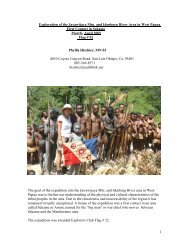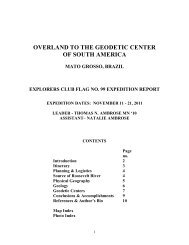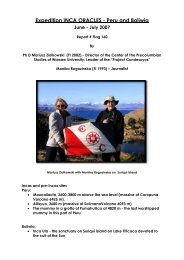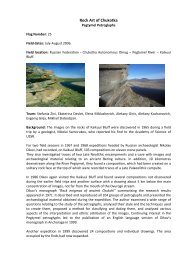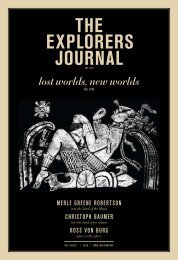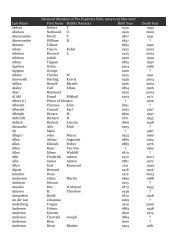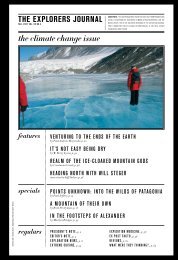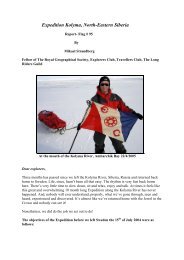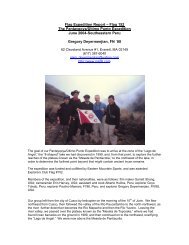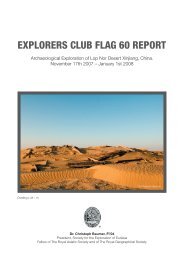the explorers journal the global adventure issue - The Explorers Club
the explorers journal the global adventure issue - The Explorers Club
the explorers journal the global adventure issue - The Explorers Club
- No tags were found...
You also want an ePaper? Increase the reach of your titles
YUMPU automatically turns print PDFs into web optimized ePapers that Google loves.
<strong>the</strong> world, particularly those in Patagonia, whichI did in 2002. After that project, I continued tofocus on environmental <strong>issue</strong>s.JS: How did you choose Antarctica as a “canvas”for your work?AJ: I had been in contact with scientists from <strong>the</strong>Dirección Nacional del Antártico, Argentina, whohad been carrying out climate research in Antarcticafor many years. I knew that vast expanses ofice had been melting at an alarming rate with <strong>the</strong>temperature on <strong>the</strong> Antarctic Peninsula slowly risingbecause of climate change and I felt it wasimportant to do what I could to heighten publicawareness of this. I decided to actually make art<strong>the</strong>re. I was excited by <strong>the</strong> notion of going Antarcticato set up video installations and carry outperformances on <strong>the</strong> ice.JS: Am I correct in imagining that <strong>the</strong>re were technicalchallenges involved in producing <strong>the</strong>se works?AJ: I knew from <strong>the</strong> beginning it wouldn`t be aneasy project to develop. I had to transport a lotof equipment to Antarctica—high-resolution andluminosity projectors, audio equipment, and a lotof accessories. Antarctica is <strong>the</strong> largest deserton Earth and, paradoxically, it is also <strong>the</strong> world’slargest reservoir of fresh water. <strong>The</strong>re’s no clock,meteorology sets <strong>the</strong> time. <strong>The</strong>re’s no money, nocurrency, no business, or stores. Beautiful landscapesare changing all <strong>the</strong> time. For an artist, itis truly a blank canvas. Despite its tranquility, it isalso an ailing world. <strong>The</strong> goal of <strong>the</strong> entire projectwas to highlight <strong>the</strong> effect of climate change on<strong>the</strong> environment and its degradation with <strong>the</strong> appearanceof methane gas particles on <strong>the</strong> surface,and <strong>the</strong> disintegration of <strong>the</strong> Larsen Ice Shelf.JS: So how many works were you able to create<strong>the</strong>re and were <strong>the</strong>y all done on one trip?AJ: I have made four trips to Antarctica duringwhich I have been able to project two videos Ihad made in Buenos Aires onto <strong>the</strong> ice, using differentback drops. We have also carried out twoperformances on <strong>the</strong> ice, which we recorded. <strong>The</strong>first, in 2004, was at Esperanza Base on <strong>the</strong> AntarcticPeninsula. <strong>The</strong>re, members of <strong>the</strong> communitymoved in <strong>the</strong> dark, carrying torches, toward<strong>the</strong> glacier base some 2,000 meters away, <strong>the</strong>irfootprints in fresh snow making a kind of path thatwould be visible in <strong>the</strong> next day’s morning light. Iprojected images of sunflowers and fire 100 metershigh and 60 meters wide onto <strong>the</strong> ice. As <strong>the</strong>people walked up <strong>the</strong> glacier, <strong>the</strong>y zigzagged in<strong>the</strong> snow, playing and skipping. <strong>The</strong>n I projected<strong>the</strong> images of sunflowers and fire onto <strong>the</strong>ir orangegarments. For <strong>the</strong> audio portion, music wasplayed at full volume to match <strong>the</strong> saturated colorsof <strong>the</strong> images. In <strong>the</strong> film, <strong>the</strong> sunflowers eventuallycatch fire, burning one after <strong>the</strong> o<strong>the</strong>r until <strong>the</strong>whole field of flowers becomes a huge, devastatingblaze, which <strong>the</strong>n dies out. It was snowing and<strong>the</strong>re was no wind; it was an astonishing night.In February 2005, we had a snowmobile crewtake us up <strong>the</strong> same glacier, where we carriedout our performance called “Red”—recorded withvideo and still cameras. <strong>The</strong>re, we unfurled an80-meter-long piece of red tulle over <strong>the</strong> glacier’ssurface. <strong>The</strong> fabric was unfolded on <strong>the</strong> snow by aperformer dressed in red. Red symbolized <strong>the</strong> ideaof a wound, blood, heat, pain, <strong>the</strong> human essence,contrasting with <strong>the</strong> purity of <strong>the</strong> ice.In January and February 2006, on my third offour expeditions to Antarctica, I carried out differentperformances that form part of my “Methane”series. I used different colored tulle—in poisonousviolet, fluorescent orange, and light blue—forthis series of videos, which we recorded during astorm, we let <strong>the</strong> tulle trail through <strong>the</strong> air, a metaphorfor toxic gases spreading everywhere.JS: Has it been easy to find support for your project?AJ: I received <strong>the</strong> Guggenheim Fellowship for <strong>the</strong>project, which was made under <strong>the</strong> auspices ofDirección Nacional del Antárctico and <strong>the</strong> ProgramaAntárctico Argentino. <strong>The</strong> pieces createdduring <strong>the</strong> project have been shown in Rotterdam,New York, Montreal, and Buenos Aires.JS: So what is next?AJ: My next project will focus on what I call <strong>the</strong>invisible forest, <strong>the</strong> phytoplankton—<strong>the</strong> first sequencein <strong>the</strong> food chain—and how it is modifiedby climate change and pollution.I n f o r m a t i o nAndrea Juan is a member of <strong>the</strong> Argentine Association: Tierrade Exploradores (Land of <strong>Explorers</strong>) www.landof<strong>explorers</strong>.org. An exhibition of her work will be on view at <strong>the</strong> Econcentroin Puerto Madryn, Patagonia, Argentina, through March 2008.<strong>the</strong> <strong>explorers</strong> <strong>journal</strong>



